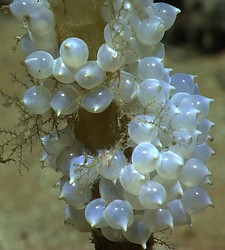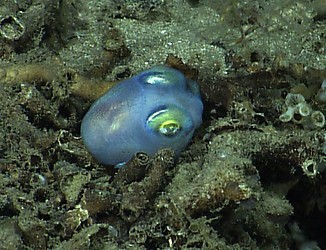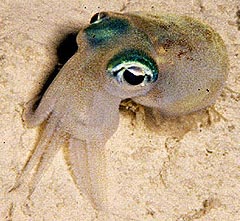Rossiinae
Richard E. Young and Michael Vecchione


This tree diagram shows the relationships between several groups of organisms.
The root of the current tree connects the organisms featured in this tree to their containing group and the rest of the Tree of Life. The basal branching point in the tree represents the ancestor of the other groups in the tree. This ancestor diversified over time into several descendent subgroups, which are represented as internal nodes and terminal taxa to the right.

You can click on the root to travel down the Tree of Life all the way to the root of all Life, and you can click on the names of descendent subgroups to travel up the Tree of Life all the way to individual species.
For more information on ToL tree formatting, please see Interpreting the Tree or Classification. To learn more about phylogenetic trees, please visit our Phylogenetic Biology pages.
close boxIntroduction
Members of the Rossinae are among the larger sepiolids reaching up to 10 cm ML (Reid, 1991). They are benthic and mostly occupy the outer portions of the continental shelves and upper regions of the slope. The subfamily nearly has a world wide distribution (see below) along parts of major land masses but is not know from Antarctic waters.
Brief diagnosis:
A sepiolid ...
- with dorsal mantle free from head.
- without ventral mantle shield.



Figure. Left - Anterodorsal view of a Rossinae sitting on the ocean floor at 1100 m. Note the dorsal separation between head and mantle. Right - Side view of a swimming Rossinae at 1033 m, showing the ventral surface of the mantle which lacks any trace of a ventral shield. Note that the tentacle is coiled inward and not retracted into a pocket as in sepiids.
Characteristics
- Arms
- Interbrachial web weakly developed between arms I-III.
- Non-hectocotylized arm suckers in 2 series in most species but 4 series in at least two species.
- One or both dorsal arms of male hectocotylized; often with suckers in two or four series among other modifications.
- Tentacles
- Tentacular clubs usually expanded.
- Keel along full length of club.
- Mantle
- Mantle free from head in nuchal region; nuchal cartilage present.
- Gladius
- Gladius fully-developed but thin posteriorly.
- Viscera
- Bursa copulatrix absent.
- Photophores
- Photohores, when present, with with small, separate oval lenses.
Comments
The following table compares the four genera.
| Arms II, III with greatly enlarged suckers | Clubs expanded | Club sucker series | Photophores present on ink sac | Functional Ink sac | Anal flaps | |
| Austrorossia* | No | No | 25-50 | No | Yes | Rudiment |
| Neorossia | No | Yes | 6-7 | No | No | Rudiment |
| Rossia | No | Yes | 6-12 | No | Yes | Strong |
| Semirossia | Yes | Yes | 5-8 | Yes | Yes | Strong |
Austrorossia is often considered a subgenus of Rossia (Voss, 1956; Reid, 1991). We follow the classification of Nesis (1982/87).
Life History
Rossinae females lay each egg in a capsule attached either to the substrate or another capsule to form a cluster of capsules.



Figure. Rossinae egg cluster from the same area in the Gulf of Mexico. Left - A recently laid cluster at a depth of 540m attached to the sponge, Topsentia sp. The individual capsules are approximately 1 cm in width. Middle - An older cluster, at a depth of 550 m, with embryos close to hatching (note the eyes within the capsules), attached to an octocoral. Right - A small Rossinae, ca. 2 cm in length, photographed about the same time and place as the egg capsules and probably of the same species.
References
Reid, A. 1991. Taxonomic Review of the Australian Rossiinae (Cephalopoda: Sepiolidae), with a Description of a New Species, Neorossia leptodons, and Redescription of N. caroli (Joubin, 1902) . Bulletin of Marine Science, 49(3)(1991):748-831.
Young, R. E., M. Vecchione and D. Donovan. 1998. The evolution of coleoid cephalopods and their present biodiversity and ecology. South African Jour. Mar. Sci., 20: 393-420.
Voss, G.L. 1956. A Review of the Cephalopods of the Gulf of Mexico. Bulletin of Marine Science of the Gulf and Caribbean, 6(2):85-178.
Title Illustrations

| Scientific Name | Rossia sp. |
|---|---|
| Location | Off N.E. United States |
| View | Dorsolateral |
| Image Use |
 This media file is licensed under the Creative Commons Attribution-NonCommercial License - Version 3.0. This media file is licensed under the Creative Commons Attribution-NonCommercial License - Version 3.0.
|
| Copyright |
© 2004

|
| Scientific Name | Rossia glaucopis |
|---|---|
| Reference | Verrill, A.E. 1880-1881. The cephalopods of the north-eastern coast of America. Part II. The smaller cephalopods, including the "squids" and the octopi, with other allied forms. Transactions of the Connecticut Academy of Sciences, 5(6):259-446, 33 plates. |
| View | Dorsal |
| Size | 23 mm ML |
| Scientific Name | Rossia glaucopis |
|---|---|
| Reference | Verrill, A.E. 1880-1881. The cephalopods of the north-eastern coast of America. Part II. The smaller cephalopods, including the "squids" and the octopi, with other allied forms. Transactions of the Connecticut Academy of Sciences, 5(6):259-446, 33 plates. |
| View | Ventral |
| Size | 31 mm ML |
About This Page

University of Hawaii, Honolulu, HI, USA

National Museum of Natural History, Washington, D. C. , USA
Page copyright © 2019 and
 Page: Tree of Life
Rossiinae .
Authored by
Richard E. Young and Michael Vecchione.
The TEXT of this page is licensed under the
Creative Commons Attribution-NonCommercial License - Version 3.0. Note that images and other media
featured on this page are each governed by their own license, and they may or may not be available
for reuse. Click on an image or a media link to access the media data window, which provides the
relevant licensing information. For the general terms and conditions of ToL material reuse and
redistribution, please see the Tree of Life Copyright
Policies.
Page: Tree of Life
Rossiinae .
Authored by
Richard E. Young and Michael Vecchione.
The TEXT of this page is licensed under the
Creative Commons Attribution-NonCommercial License - Version 3.0. Note that images and other media
featured on this page are each governed by their own license, and they may or may not be available
for reuse. Click on an image or a media link to access the media data window, which provides the
relevant licensing information. For the general terms and conditions of ToL material reuse and
redistribution, please see the Tree of Life Copyright
Policies.
- First online 30 August 2004
- Content changed 06 July 2014
Citing this page:
Young, Richard E. and Michael Vecchione. 2014. Rossiinae . Version 06 July 2014 (under construction). http://tolweb.org/Rossiinae/20023/2014.07.06 in The Tree of Life Web Project, http://tolweb.org/














 Go to quick links
Go to quick search
Go to navigation for this section of the ToL site
Go to detailed links for the ToL site
Go to quick links
Go to quick search
Go to navigation for this section of the ToL site
Go to detailed links for the ToL site